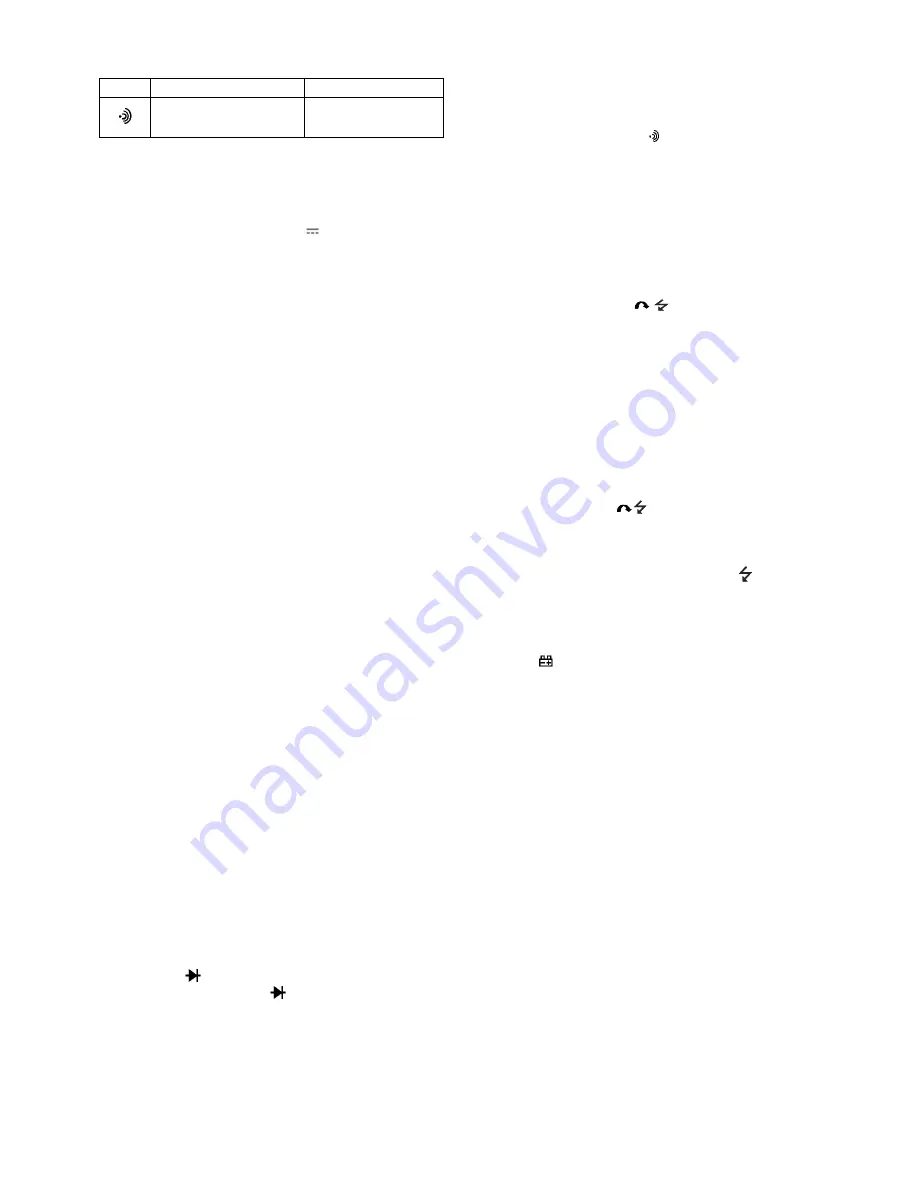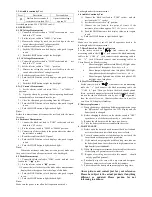
3.2.6 Audible continuity Test
Range
Description
Test condition
Built-in buzzer sounds if
resistance is less than 30
Ω
.
Open circuit voltage
approx 3V
Overload protection: 250V DC/250Vrms AC.
4. OPERATION
4.1 DC Voltage Measurement
1) Connect the black test lead to "COM" socket and red test
lead to the "V" socket.
2) Set the selector switch to "1000V
" position.
3) Measure the voltage by touch the test lead tips to the test
circuit where the value of voltage is needed.
4) Read the result from the LCD panel.
5)
Push the HOLD button to lock display value, push it again
to exit.
6)
Push the LIGHT button to light the back light.
4.2 AC Voltage Measurement
1) Connect the black test lead to "COM" socket and red test
lead to the "V" socket.
2) Set the selector switch to "750V
~
" position.
3)
Measure the voltage by touch the test lead tip to the test
circuit where the value of voltage is needed.
4) Read the result from the LCD panel.
5) Push the HOLD button to lock display value, push it again
to exit.
6)
Push the LIGHT button to light the back light.
4.3 AC Current Measurement
1) Set the selector switch to desired "20A
~
" or "1000A
~
"
position.
2) Open the clamp by pressing the jaw-opening handle and
insert the cable to be measured into the jaw.
3) Close the clamp and get the reading from the LCD panel.
4) Push the HOLD button to lock display value, push it again
to exit.
5) Push the LIGHT button to light the back light.
Note:
Before this measurement, disconnect the test lead with the meter
for safety.
4.4 Resistance Measurement
1) Connect the black test lead to "COM" socket and red test
lead to the "Ω" socket.
2) Set the selector switch to "200Ω" or “2000Ω” position.
3) Connect tip of the test leads to the points where the value of
the resistance is needed.
4) Read the result from the LCD panel.
5) Push the HOLD button to lock display value, push it again
to exit.
6) Push the LIGHT button to light the back light.
Note:
When take resistance value from a circuit system, make sure
the power is cut off and all capacitors need to be discharged.
4.5 Diode Measurement
1) Connect the black test lead to "COM" socket and red test
lead to the "
Ω
" socket.
2) Set the selector switch to "
" position.
3) Connect the test leads across the diode under measurement,
display shows the approx. forward voltage of this diode.
4) Push the HOLD button to lock display value, push it again
to exit.
5) Push the LIGHT button to light the back light.
Note:
Make sure the power is cut off and all capacitors need to be
discharged under this measurement.
4.6 Audible Continuity Test
1)
Connect the black test lead to "COM" socket and red
test lead to the "
Ω
" socket.
2)
Set the selector switch to "
" position.
3)
Connect the test leads to two point of circuit, if the
resistance is lower than approx. 30
Ω,the buzzer sounds .
4)
Push the HOLD button to lock display value, push it again
to exit.
5) Push the LIGHT button to light the back light.
Note:
Make sure the power is cut off and all capacitors need to be
discharged under this measurement.
4.7 Three Phase Live Wire Identification
Set the rotary switch to “
”,And connect the yellow
measuring cable to the
“V
Ω
a” jack ,connect the black measuring
cable to the “ COM b” jack ,connect red the measuring cable to
the. “c” jack .Afterward connect three measuring cables to
Three Phase Live Wire By testing .
a.
Phase lamp light and three lack Phase LED light ,show
phase order of three phase live wire is :a , b , c
b.
Phase lamp not light and three lack phase LED light ,
show phase order of three phase live wire is : c, b , a
c.
Phase lamp not light and one of three lack phase LED
not light, show lack phase.
4.8 Live Wire Differentiate
Set the rotary switch to “
” ,And connect the red measuring
cable the “ c” jack ,connect the black measuring cable the
“ COM b ” jack .Then you hold to the black shank by hand
(Note : not brush up against test metal head of the black shank ),
connect the red test head to the wire by test , if “
” sign wink ,
show the wire is live wire . Otherwise show the wire is not live
wire .Here LCD display is faradism.
5.
Battery replacement
1) When the battery voltage drop below proper operation range
the “ ”symbol will appear on the LCD display and the
battery need to changed.
2) Before changing the battery, set the selector switch to "OFF".
open the cover of the battery cabinet by a screwdriver.
3) Replace the old battery with the same type battery.
4) Close the battery cabinet cover and fasten the screw.
6. MAINTENANCE
1) Before open the battery door, disconnect both test lead and
never uses the meter before the battery door is closed.
2) To avoid contamination or static damage, do not touch the
circuit board without proper static protection.
3) If the meter is not going to be used for a long time, take out
the battery and do not store the meter in high temperature or
high humidity env
ironment.
4) When take current measurement, keep the cable at the center
of the clamp will get more accurate test result.
5)
Repairs or servicing not covered in this manual should
only by qualified personal.-
6) Periodically wipe the case with a dry cloth and detergent.
Do not use abrasives or solvents on this instruments.
7) Please take out the battery when not using for a long time.
Above picture and content just for your reference.
Please be subject to the actual products if anything
different or updated. Please pardon for not
informing in advance.


